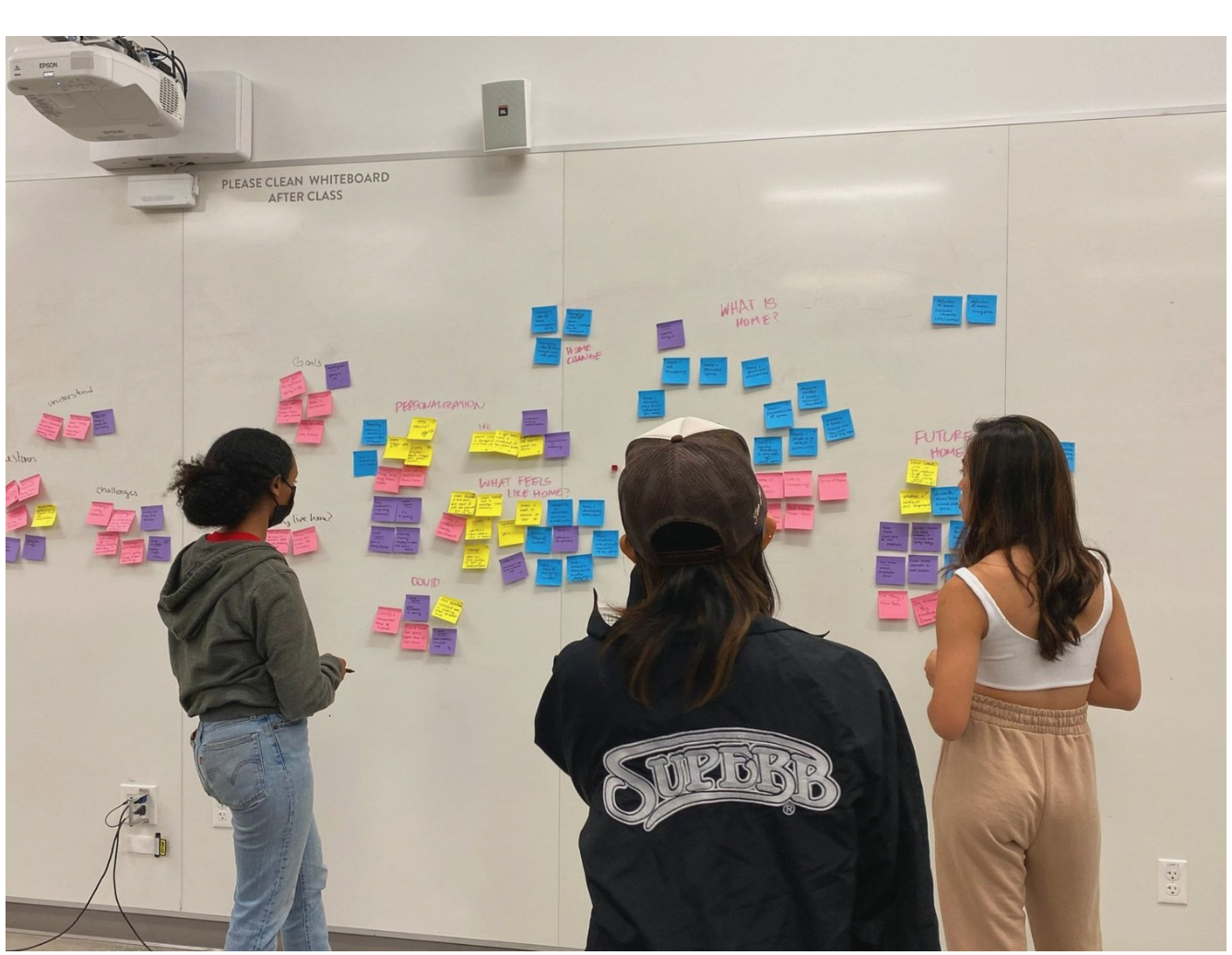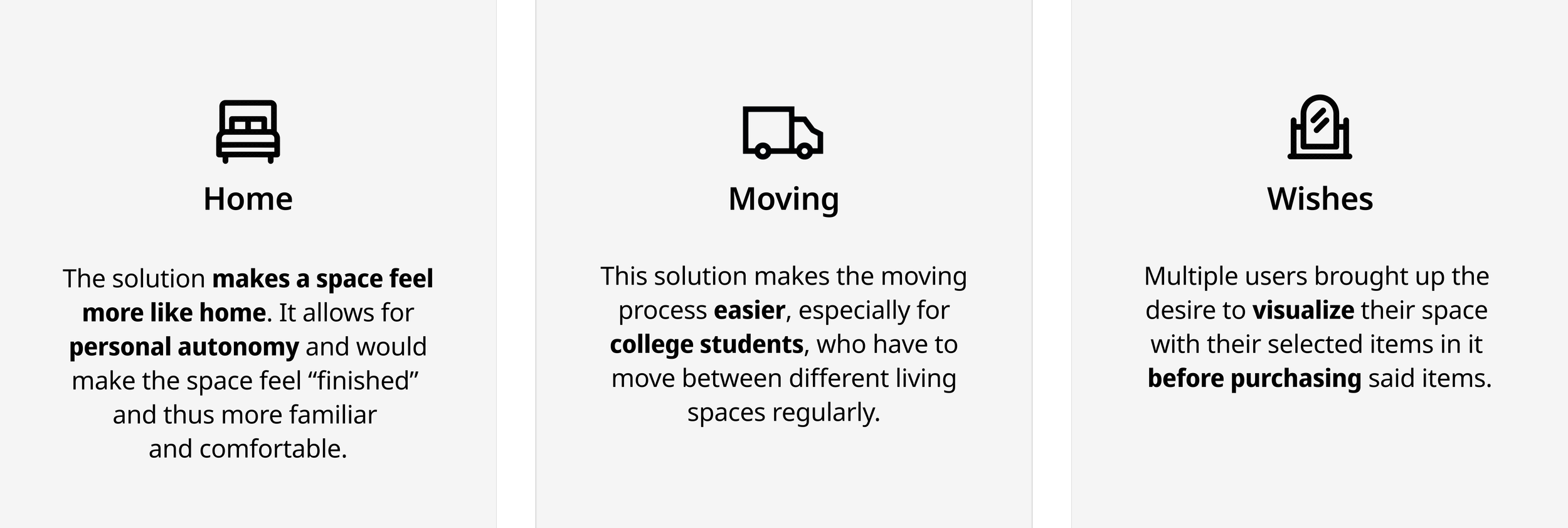Bundle
of Home
Re-envisioning traditional shopping experiences
Role
Product Designer (Contract)
Context
Timeline
Sep 2021 - Dec 2021
Design Team
Mahlet C.
Shin C.
Avey S.
Disciplines
UX Research
UX Design
User Testing
Spatial Design
Tools
Figma
Miro
SolidWorks
IKEA is a global Scandinavian retailer specializing in home furnishing. Balancing quality, sustainability, form, affordability, and function, IKEA has the underlying vision of creating a better everyday life for its consumers. Through Berkeley Innovation, I had the opportunity to work alongside IKEA’s Innovation and Co-Creation team in re-envisioning the shopping experience for Gen Z, making it more accessible.
These ideas have been launched by IKEA! Check it out at IKEA.com and in physical stores.
IKEA’s current user base encompasses those in their late-20s to mid-30s. However, IKEA wanted to tap into the up-and-coming Gen Z user base and was having difficulty doing so (Gen Z being defined as those born in the mid-to-late 1990’s to the early 2010’s). Being a company that values innovation and recognizing a new generation meant adapting to their desires, IKEA approached us with a very broad and open-ended question:
THE PROBLEM
“How might we create a non-traditional, non-store experience for Gen Z*?”
IKEA challenged us to reimagine the typical in-store shopping experience, making it more innovative and catering it to this rising demographic. More specifically, IKEA wanted us to focus on the idea of home + lifestyle.
RESEARCH
Being a part of this Gen Z demographic, we were able to draw from our personal experiences to guide our research. We were able to draw connections among each other to note what shared notions/experiences we had. However, we wanted to test this with a larger audience and understand whether other Gen Z members felt the same and what their interpretations of home + lifestyle were. We conducted our research with the following goals in mind:
Our research methodologies consisted of a survey and user interviews.
While surveys allowed us to determine, for instance, how much people value different aspects of home or how they rank their life milestones (via self-ranking, Likert scales, etc.), conducting interviews in our interviewee’s personal living space allowed for more intimate responses as interviewees could easily draw connections from objects within their room. This was essential, as our research relied on a sense of trust and openness to gain transparent and raw insights.
SYNTHESIZING
Grouping all our insights together…
Our research indicated how the feeling of home was difficult to establish for this particular demographic, as people within this demographic are constantly going through changes and moving between different living environments. Additionally, this demographic wasn’t especially drawn to just material objects; they were more connected with objects they had a personal connection to (i.e. mementos, pictures, etc.). Accessing these feelings would be difficult for a corporation such as IKEA.
KEY INSIGHTS
With this in mind, we decided it was best to reapproach and refine the question we started off with to better reflect the insights we collected. We pivoted our guiding question to:
“How might we make designing/creating the feeling of home more accessible to Gen Z?”
We wanted to find a way to best support this demographic as they were navigating through their lives. A Gen Z member is experiencing so many firsts in their lives: how can IKEA come in and help with those varying experiences?
IDEATION
So what exactly is accessibility? Accessibility as a definition is very broad, so we wanted to figure out what forms of accessibility to focus on. We did a definition brainstorm and selected our definitions based on feasibility and stakeholder needs. We defined accessibility as:
EASY TO UNDERSTAND/COMPLETE
The shopping experience should remain simple and intuitive.
LOW BARRIERS TO ENTRY
Physical implementation of the product should be feasible.
AFFORDABLE
Financial barriers should not serve as potential blockers for customers.
INCLUSIVE
Autonomy should be governed for differing customer needs.
With a better understanding of what accessibility entailed, we started a rapid brainstorming session, listing any ideas that could possibly answer our problem scope.
We individually compared our ideas against all our definitions of accessibility, narrowing in on a final idea based on whether it satisfied all our definitions of accessibility and talking through our ideas with the clients. We settled on a final idea, IKEA: Bundle of Home.
IKEA has always reinforced the idea of thinking outside the box and encouraged us to do the same.

A service design where one can easily order a “bundle” of items. Items would be delivered in a way that makes it easy to pack up, move, and transport between living spaces. Users can customize their bundles based on their personal tastes and preferences and have the option of purchasing pre-bundled collections.
FINAL SOLUTION: IKEA: Bundle of Home
Personalized Bundles
Personalization and customization are strong desire factors for Gen Z. To account for this, users can take a quiz that assesses their shopping motives, living space conditions, and style preferences.
Users would then be recommended a bundle of items specially curated for them which they can edit as they please (add/remove items, change color options, etc.). Opting for this quiz option allows users to have a sense of control over the items they are recommended.
To simplify the home furnishing process, users can alternatively enter the IKEA site and choose from various preset bundle collections. They can then edit the bundle as they wish.
Curated Bundles
The items would then be packed into a box that could be picked up from the store or shipped to one’s residence. The items would come with a clear, easy-to-understand graphic that shows how to arrange the items within the box in order to make the re-packing process easier while also optimizing space.
Packed with Intention
Our solution has the underlying goal of making a space feel like home by simplifying the home furnishing process. Users are recommended a set of items they can individually or collectively choose from based on their personal preferences. Moreover, our solution eases the transitional stage by making unpacking and re-packing easier.
USER TESTING
To assess the validity of the solution, we conducted some rapid user testing. We asked some key questions after showing the user the prototype alongside explaining the process:
Does this product invoke the feeling of home?
Would this product make transitioning into living spaces easier?
Recommendations/wishes?
We conducted 15 user testing interviews and found:
NEXT STEPS + REFLECTIONS
As our time in this project had to come to an end, we did have some future recommendations and final insights for what the final product could look like and who it could be targeted towards based on the feedback we received.
Narrow in on evoking certain emotions, such as comfort and familiarity, instead of an abstract idea of home. Focus on the users’ desire to create such emotions in their personal spaces.
01
This solution is most relevant to people such as college students, who are moving the most throughout this stage in their life.
02
Combine this solution with AR/VR implementations, so that users can further curate, control, and personalize their living environments.
03
Given more time, I would have loved to expand more on the physical design prototypes. While it did fall slightly out of the project scope, it would have been exciting to create the re-packing infographic and maybe a 3-D rendition of all the items packed within the box… and maybe some AR/VR room visualization tool… and… I’ll stop myself before I get upset.
Closing
Our team’s favorite IKEA item: the “DJUNGELSKOG."
Such a content looking bear.
I really enjoyed this whole process and appreciate how receptive the team was. This project has even made me reflect on my own definition of home. This was an incredibly rewarding project, and I’m so grateful for my team.
Special thanks to the IKEA team: Kyra, Christina, Illana, Kris, Thomas, and all who have helped us throughout this project!















